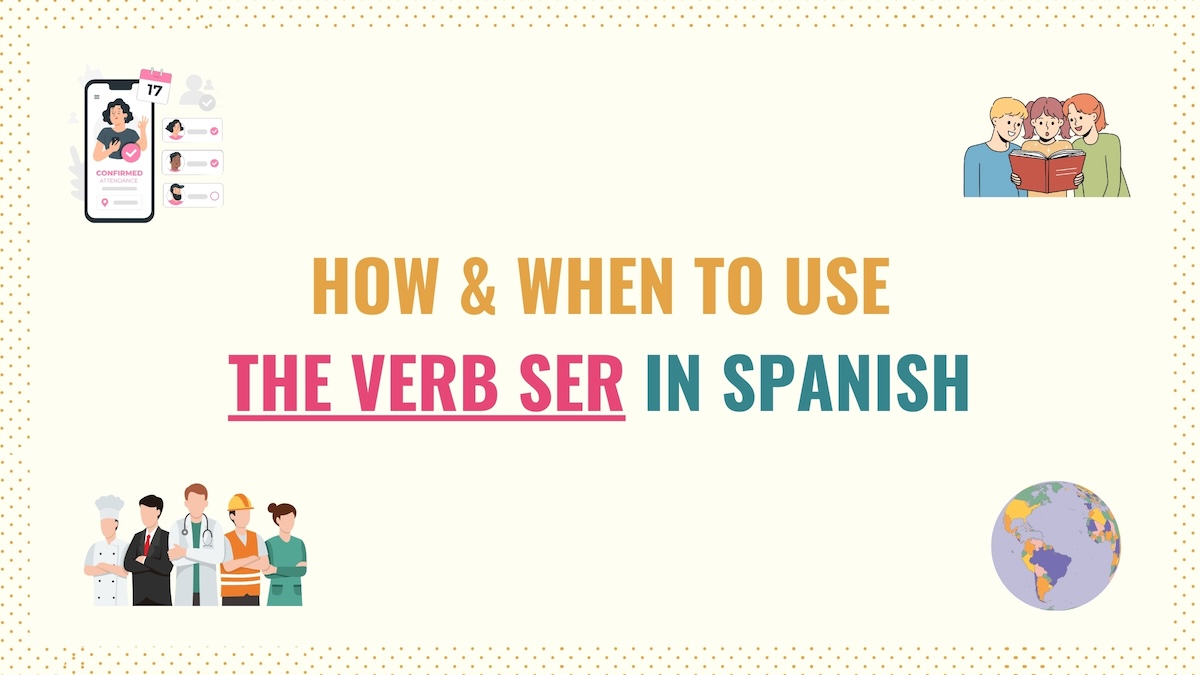As a key Spanish verb, it’s essential to understand how and when to use ser. Ser conveys information related to inherent qualities, which are characteristics associated with an object or person’s identity. Some of the information ser conveys includes:
- Identifying people or things
- Time and date
- Location of events
- Descriptions
- Origin
- Profession
- Relationships and possessions
- Passive voice
Sus papás son doctores.
His parents are doctors.
Yo soy Daniela y ella es mi mamá.
I am Daniela and she is my mom.
¿De qué parte de España eres?
What part of Spain are you from?
When to Use Ser Key Points
- Ser means ‘to be’, but it refers to inherent qualities. Characteristics a person was born with or an object created.
- It’s paired with adjectives of physical appearance, personality, or nationality.
- It only indicates the location of events. The location of people, places, and things is conveyed by estar.
- ‘Ser de + noun’ is the formula to express origin or the material of something.
- The passive voice with ser focuses on the direct object of the sentence, rather than the subject. Use the structure ‘ser + past participle’ to form it.
In this guide, you’ll learn the different ways to use ser in real-life situations.
1. Using Ser for an Event’s Location
In Spanish, the location of an event is expressed with ser since this information and the type of event are inherent information. These are traits the event was created with.
La boda de Ana fue en Cancún.
Ana’s wedding was in Cancun.
Mi graduación va a ser en el auditorio.
My graduation is going to be in the Auditorium.
La fiesta será en el salón que está en el parque.
The party will be in the salon that’s in the park.
Examples of nouns that you can combine with ser are:
- Bautizo: Baptism
- Boda: Wedding
- Cita: Date / Appointment
- Concierto: Concert
- Examen: Exam
- Fiesta: Party
- Graduación: Graduation
- Obra: Play
2. Identifying People, Places & Things
In daily-life conversations, ser allows you to identify someone or something. This includes introducing people or pointing at things.
Esta es Alice, mi vecina.
This is Alice, my neighbor.
Yo soy la dueña de la casa, ¿usted quién es?
I am the owner of the house, who are you?
¿Aquí es la escuela de español? ¿O es enfrente?
Is the Spanish school here? Or is it across the street?
The situation exposed in example #3 often confuses learners. At first sight, it seems that we’re expressing the school’s location. However, we’re actually identifying the school from a group of buildings.
Take Note: As a tip, you can only express the location of places we know. If the place is unknown to you or the other person, you may need to use ser to identify or the impersonal form hay to express existence.
Identifying also relates to expressing possession or talking about relationships.
Esos son mis perros.
Those are my dogs.
La hija de la maestra es mi vecina.
The teacher’s daughter is my neighbor.
3. Describing Something or Someone
One of the most common applications of ser in Spanish is to describe things and people. Specifically, it describes their personality and physical traits, such as:
- Size or height
- Color (hair, eyes, skin, etc)
- Shape
- Texture
[Ser conjugated] + [adjective]
Aurora es delgada y alta.
Aurora is thin and tall.
Sus ojos son cafés y grandes.
Her eyes are brown and big.
La mesa es cuadrada y rústica.
The table is square and rustic.
Nuestra vecina es muy buena con los niños.
Our neighbor is very good with kids.
Take Note: The verb estar also describes people or objects, but focuses on slightly different information. You can check a more detailed explanation in my guide on ser vs estar.
4. Talking About a Place’s Weather
Although there are many verbs to talk about the weather in Spanish, ser is exclusively used to express how the climate of a place usually is.
- Cálido: Warm
- Caluroso: Hot
- Frío: Cold
- Tropical: Tropical
- Lluvioso: Rainy
- Húmedo: Humid
- Templado: Mild
- Seco: Dry
Esta ciudad es muy cálida y húmeda.
This city is very warm and humid.
Aquí, las noches son muy frías y secas.
Here, nights are cold and dry.
El clima en México es muy caluroso. Algunas zonas son muy lluviosas.
In Mexico, the weather is very hot. Some areas are quite rainy.
5. Ser + De: Expressing Origin & Material
The verb ser is combined with the preposition de to express a person or object’s origin:
[Ser conjugated] + de + (determiner) + [noun]
¿Eres del sur de la ciudad?
Are you from the south of the city?
Esas manzanas son de nuestro huerto.
Those apples are from our orchard.
Andrew y Mónica son de Francia. ¿Ustedes de dónde son?
Andrew and Monica are from France. Where are you from?
Take Note: You can express nationality using this structure, or you could also use an adjective of nationality.
Ser + de is also used to describe the material of something:
Sus zapatos son de cuero.
Her shoes are leather.
Quiero un vestido que sea de seda.
I want a silk dress.
La película que queremos ver es de terror.
The movie we want to see is a horror film.
¿De qué era la pizza que ordenamos? ¿Era de pepperoni?
What was the pizza we ordered? Was it pepperoni?
Take Note: When referring to possession, the structure ser + de allows you to clarify or introduce the owner of something for the first time.
Esas llaves no son tuyas, son de Lauren.
Those keys are not yours, they are Lauren’s.
6. Talking about Profession or Long-Term Occupations
A person’s profession or trades are part of his or her identity. As a result, this information is also delivered with the verb ser.
[Ser conjugated] + [noun]
Mi hermanito quiere ser astronauta.
My baby brother wants to be an astronaut.
Raúl es futbolista y su esposa es pintora.
Raul is a soccer player and his wife is a painter.
Marina y Carla son meseras en ese restaurante.
Marina and Carla are waitresses in that restaurant.
7. Expressing Affiliations
In daily-life situations, native Spanish speakers also use ser to express religious or political affiliations since this information conveys who a person is.
Mis papás son católicos.
My parents are catholic.
Esos candidatos son socialistas.
Those candidates are socialist.
Chris no es cristiano, creo que es ateo.
Chris is not Christian, I think he is atheist.
8. Saying or Asking for the Price
In the context of buying and paying for things, ser is used to ask for the total price of something:
¿Cuánto es?
How much is it?
Fueron doscientos pesos de los boletos.
It was two hundred pesos for the tickets.
Van a ser cincuenta dólares por los dos.
It’s going to be fifty dollars for the two of you.
You can also use the formal question ¿cuál es el precio de…? to inquire about the price of something.
Disculpe, ¿cuál es el precio de las flores?
Excuse me, what is the price of the flowers?
9. Forming the Passive Voice
In Spanish, ser is one of the key elements to form the passive voice, which is used to emphasize the direct object in a sentence.
[Ser conjugated] + [past participle]
El libro fue publicado en 1990.
The book was published in 1990.
Esa pintura será vendida al mejor postor.
That painting will be sold to the best bidder.
Todas las aplicaciones son revisadas cuidadosamente.
All the applications are carefully reviewed.
Take Note: In this context, the Spanish past participles work as adjectives. As a result, they must agree with the noun in gender and number.



